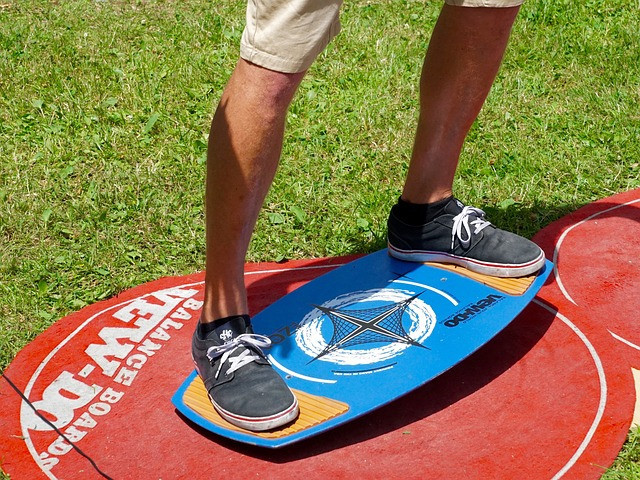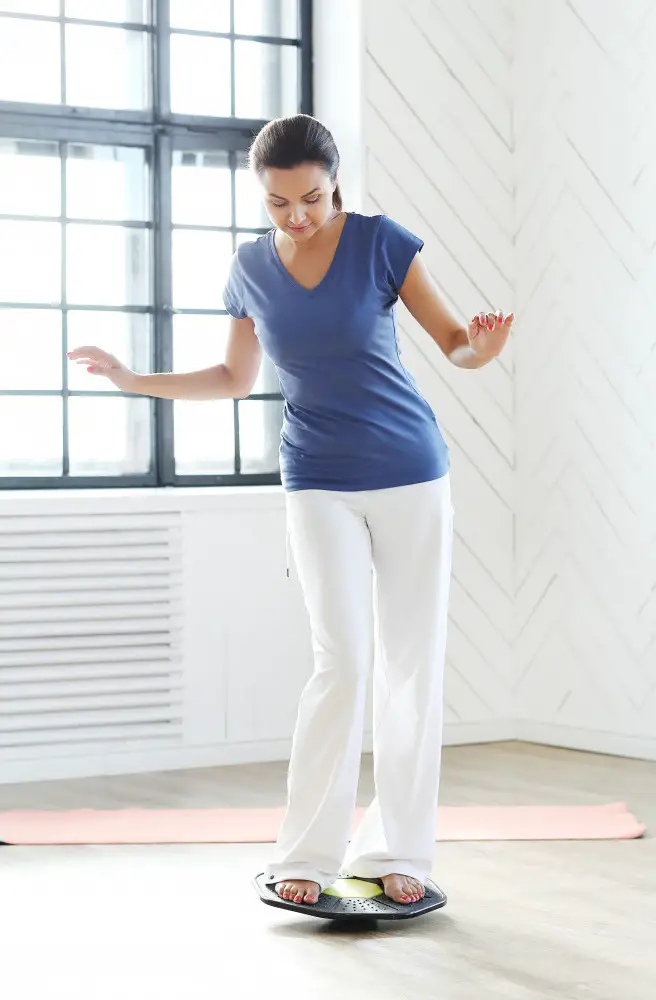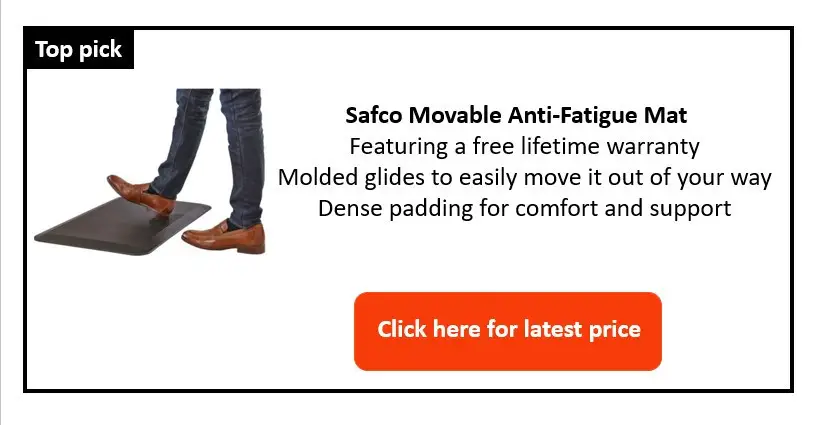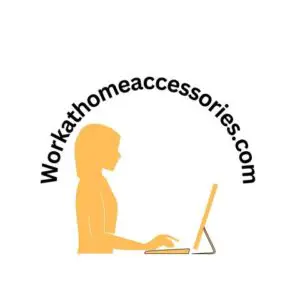If you’re looking into items to help increase your activity and comfort, you may have come across balance boards. But with so many types available, it can be overwhelming to decide which one is best for you. In this article, I provide you with a cheat sheet on how to choose a balance board?
This article is guaranteed to help you decide which one is more suited to you.
Plus, find out which type of balance board is suited for your purpose, level of stability and comfort.

What is a balance board?
A balance board is a platform which generally pivots on a dome, curved base or a cylindrical shape to introduce a range of movements and instability to the board while you stand on it. The objectives of a balance board include improving your stability and posture while also giving your body a workout.
When used as a standing desk balance board, they encourage activity by introducing micro-movement into your stance. Source
How to choose a balance board?
When choosing a balance board, the below factors will be influential in choosing one that is suited to your requirements and area.
1. Purpose
2. Range of motion
3. Stability
4. Duration
5. Shape
6. Size
7. Material
8. Quality
9. Weight
10. Weight capacity
11. Height of user
12. Cost
13. Warranty
Below is a comparison table to give you a quick overview of the main differences between the different types of balance board.
|
Features |
Rocker balance boards |
Wobble balance boards |
Roller balance boards |
Half balance boards |
|
Shape |
Rectangle with curved base |
Disc shaped with curved base |
Rectangle with cylinder underneath |
Inflated dome shape with flat side |
|
Stability |
Medium – high |
Low – medium |
Low – medium |
Low |
|
Cushioning |
Minimal |
Yes for ball cushions, minimal for discs |
Minimal |
Yes |
|
Surface |
Flat |
Curved or flat |
Flat |
Flat or semi-circle |
|
Level of focus required |
Low |
Medium |
High |
High |
|
Range of motion |
Forward and back or side to side |
360 degrees |
Side to side |
360 degrees |
|
Suitability for standing desks |
Excellent |
Good |
Good |
Low |
|
Difficulty level |
Easy |
Medium |
Hard |
Hard |
|
Suitable for beginners |
Yes |
Yes, if larger board |
No |
No |
|
Cost |
$$ |
$ |
$$ |
$$$ |
Purpose
The purpose of balance boards tends to be for exercise and rehabilitation, but they can also be used to prevent injury and strengthen motor stills. However, with an incremental rise in balance boards being used at standing desks and workstations, the purpose now also includes increasing movement while you stand.
The purpose for investing in a balance board will dictate which type that you choose. Why do you want a balance board?
If it’s for exercise, rehabilitation or strengthening motor skills, your physical therapist or trainer may prescribe a particular type of balance board.
If it’s for increasing activity while you stand at a standing desk, then the standing desk balance boards are popular choice, such as the Pono Board or those by FluidStance. These types of boards are designed specifically for use at a standing workstation.
Perhaps you intend to use the balance board both at your standing desk and also as a training aid. If that is the case, pay attention to how suitable the balance board will be for your desk.
This is probably more of a consideration because most balance boards will add some level of challenge to your training aid, however, not all balance boards will be particularly suitable for a standing desk. This is especially true for ones with high instability.
Range of motion
Rocker balance boards
Also known as standing desk balance board, it allows you to rock backwards and forwards or left to right.
Wobble balance boards
Also known as a balance disc, these enable 360 degrees of movement in all directions.
Roller balance boards
Roller balance boards encourage movement from left to right.
Half balance boards
Half balance boards are also known as balance balls, balance trainers or bosu balls, and are most commonly observed in gyms or fitness classes. They offer the largest range of motions of all of the balance boards available.
Tip: Due to their height and instability, balance balls may not be appropriate for standing desks, especially if you are too tall for the desk while standing on the bosu ball.
Hybrid balance board
These boards can feature adjustable blocks underneath the surface of the which can be adjusted to allow varying ranges of movement, depending on how the blocks are arranged.
The Fitterfirst Active Office Board is an example of a hybrid board that offers this feature, and the below video shows how you can adjust the difficulty of stability depending on your preferred position. They’re pretty nifty!
Stability
Perhaps you’re wondering what balance board is easiest to use?
Rocker balance boards are one of the easiest types of balance boards to use. Therefore, they are generally recommended for beginners or people with poor stability. They are also ideal for people intending to use them at standing desks, as they don’t detract from your attention too much.
Wobble balance boards and discs offer less stability than a rocker board, this is attributable to the full range of motion that they can achieve.
Roller balance boards are one of the most difficult types of balance boards to use. Therefore, they are not generally suited to beginners because of this.
What balance board is hardest to use?
Half balance boards are often considered the balance board with the greatest degree of difficulty. You have the option of standing on the flat side or on the inflated side. Due to their height and the degree of curvature on the dome, they can be difficult to master.
Hybrid balance boards allow you to adjust between beginner, intermediate and advanced levels of stability. So, you don’t have to choose between low, moderate or high level of stability.
If you intend to use a balance board or a wobble board with a standing desk and you are concerned about losing balance or focus, it may be best to opt for a balance board which features a higher degree of stability and also doesn’t detract from your focus.
After all, an element of your attention will need to be assigned to maintaining balance on the standing desk balance board to ensure that you do not fall off.
Duration
In terms of how long you should use a balance board, sessions do not have to be long; they should last about 10 – 15 minutes for optimal effect when using it to perform exercise. When using a balance board for a standing desk, Fluid Stance recommend the 70:20:10 model:
- 70% of the time: Working at your desk as normal, whether standing or sitting.
- 20% of the time: Standing on your balance board.
- 10% of the time: Engaging in normal exercise and movement.
If you based your working hours on the 70:20:10 model, 20% of your time would equate to the time in the below table:
|
Hours working |
Duration to use balance board |
|
7 hours |
1 hour 24 minutes (84 minutes) |
|
8 hours |
1 hour 36 minutes (96 minutes) |
|
9 hours |
1 hour 48 minutes (108 minutes) |
|
10 hours |
2 hours (120 minutes) |
In addition to the above, the degree of challenge that a balance board imposes on you will dictate how long you can comfortably position yourself on one before feeling tired.
With the fundamental goal of regularly adjusting your posture to encourage blood flow, it’s vital that you also take regular breaks from both standing and balancing on these boards.
Shape
Rocker balance boards are similar to a skateboard in design. They feature a rectangular shape with a curved base which you pivot on.
Wobble balance boards or balance discs feature a dome on the base which you balance yourself on. They may feature a flat or slightly convex surface for standing on.
Roller balance boards look similar to a skateboard since they are flat and rectangular. They feature a cylindrical object underneath which you use to balance yourself.
The half balance board has an inflated dome on one side and a hard flat surface on the other side. Balance boards and cushions can differ slightly as they may feature a flat or slightly convex surface for standing on.
Size
So, you’re probably wondering what size balance board should I use? – A few factors come into play.
The larger the balance board, the easier it is to maintain stability.
Some products come in a range of sizes to cater to your needs and desires. There are even kids sizes available. For greater stability, opt for a larger board.
If you have larger feet or adopt a wide stance, or you simply prefer to have more space on the board, then you should opt for a slightly larger balance board.
For instance, people with a size 10 ½ shoe with a normal stance can easily be centered on a board that is 34 x 20 inches.
The most compact balance boards tend to be the balance discs. They have sizes as small as x. Bosu balls tend to consume the most footprint since they are an inflated dome. Fortunately, they can be purchased in a range of sizes, if storage or space is a concern for you. The dimensions of various types of balance boards are presented in the below table to help guide your decision.
Material
Balance boards are mostly available in 2 types of materials, wood and plastic. Some balance boards come furnished with metal components as well.
Balance discs are available in either a cushion material which can be inflated, such as plastic, or a rigid material, such as wood or hard plastic.
Quality
The quality of balance board tends to be related to the type of material and cost of the board itself. Properties to look out for include high density foam, thickness between 3/8 inches – 1 inch, a good warranty, mid-range price and positive product reviews.
The type of material on the board also indicates the quality of the balance board.
Weight
When researching how much does a balance board weigh, for transparency and an accurate depiction, I categorized the weights based on the type of balance board. The average balance board weighs between 3 – 19 lbs.
The average weight for a balance board is 7.58 lbs.
Factors that influence the weight of a balance board include the:
- type of balance board
- size of the board
- thickness
- materials used
- density
- quantity of cushioning and materials
Below are some examples of popular balance boards, their dimensions and how much they weigh to put it into perspective.
|
Name |
Type of item |
Size (inches) |
Weight (lbs) |
Material |
|
Yes4All Balance Board |
Roller balance board |
29.53 x 11.22 x 5.12 |
3 |
Wood & rubber |
|
Black Mountain Balance Disc |
Wobble balance board |
13 d |
3 |
Rubber |
|
Gaiam Balance Disc Wobble Cushion |
Wobble balance board |
16 d |
3.09 |
Rubber |
|
Yes4All Wobble Balance Board |
Round wobble balance board |
17.5 d x 3 h |
3.1 |
Wood & anti-skid |
|
StrongTek Round Wobble Balance Board |
Round wobble balance board |
16.5 d x 3.54 h |
3.5 |
Plastic and rubber |
|
Fitterfirst Active Office Board |
Hybrid balance board |
24.5 x 12 x 3.25 |
4.2 |
Wood, velcro & foam |
|
FluidStance The Plane |
Wobble balance board |
24 x 12 x 2.5 |
5 |
Rubber and plastic |
|
Steppie |
Rocker balance board |
22.4 x 14.5 x 2.1 |
5 |
PPCO plastic |
|
StrongTek Professional Wooden Balance Board |
Rocker balance board |
17.5 x 13.5 x 3 |
5 |
Wood & anti-skid |
|
Revolution 101 Balance Board Trainer |
Roller balance board |
30 x 11.5 x 0.75 |
6.77 |
Wood & plastic |
|
FluidStance The Level |
Wobble balance board |
26.5 x 12.2 x 2.5 |
7 |
Aluminium & wood |
|
BOSU Sport Balance Trainer |
Balance trainer |
22 x 7 |
10 |
Vinyl & rubber |
|
BOSU Balance Trainer |
Balance trainer |
26 x 10 |
17 |
Vinyl & rubber |
|
BOSU Pro Balance Trainer |
Balance trainer |
26 x 10 |
19 |
Vinyl & rubber |
|
BOSU NexGen Pro |
Balance trainer |
26 x 10 |
19 |
Vinyl & rubber |
Weight capacity
Balance boards are designed to withstand a certain weight threshold. Best practice is to choose a board that has at least 10% more weight capacity than you anticipate that you will require. This can act as a buffer to ensure that any unforeseen weights applied to the board are covered.
Plus, it helps ensure that the board is not put under as much pressure and it has a greater likelihood of a lasting longer.
Choosing a balance board with a weight capacity that is too low can result in the board:
- breaking
- injury to the user
- becoming compressed, particularly balance cushions
- failing to perform correctly
- failing to offer adequate support
Tip: As a general rule of thumb, the more a balance board weighs, the more weight capacity it can hold.
Height of user
If you’re using balance boards at a standing desk, then ensure that your standing desk is adjusted to accommodate this extra height.
This is particularly important for taller users as the sit-stand desk may not be able to reach the necessary height, particularly if you have it near or at the highest the desk can go.
The FluidStance balance board add approximately 2.5 to 3 inches of height.
Cost
The average cost of balance boards can range from $14.12 – $269. This will vary depending on the type of balance board. For instance, balance discs tend to cost the least, whereas wobble boards can cost the most, particularly when it is a branded model.
It is generally understood that the more you pay for a balance board, the greater the quality and durability. However, merely selecting the most expensive item available does not guarantee quality or reliability.
Instead, checking for good customer reviews, purchasing from reputable companies, and selecting a board with a good warranty length will enable you choose a board that is proportional in quality and cost.
|
Name |
Type of item |
Cost $ |
Size |
|
Black Mountain Balance Disc |
Wobble balance board |
14.12 |
13 d |
|
Gaiam Balance Disc Wobble Cushion |
Wobble balance board |
21.98 |
16 d |
|
Yes4All Wobble Balance Board |
Round wobble balance board |
21.99 |
17.5 d x 3 h |
|
StrongTek Round Wobble Balance Board |
Round wobble balance board |
32.95 |
16.5 d x 3.54 h |
|
StrongTek Professional Wooden Balance Board |
Rocker balance board |
34.99 |
17.5 x 13.5 x 3 |
|
Yes4All Balance Board |
Roller balance board |
79.72 |
29.53 x 11.22 x 5.12 |
|
BOSU Sport Balance Trainer |
Balance trainer |
98.89 |
22 x 7 |
|
Fitterfirst Active Office Board |
Hybrid balance board |
99.95 |
24.5 x 12 x 3.25 |
|
Revolution 101 Balance Board Trainer |
Roller balance board |
129.95 |
30 x 11.5 x 0.75 |
|
Steppie |
Rocker balance board |
129.99 |
22.4 x 14.5 x 2.1 |
|
BOSU Balance Trainer |
Balance trainer |
134.99 |
26 x 10 |
|
BOSU NexGen Pro |
Balance trainer |
139.99 |
26 x 10 |
|
BOSU Pro Balance Trainer |
Balance trainer |
159.95 |
26 x 10 |
|
FluidStance The Plane |
Wobble balance board |
189 |
24 x 12 x 2.5 |
|
FluidStance The Level |
Wobble balance board |
269 |
26.5 x 12.2 x 2.5 |
Data correct as of the 6th June 2021. Please refer to website for updates.
Warranty
At a minimum, there should be at least a 1-year warranty provided for a balance board. A good warranty should range from 3 to 5 years. Some standing desk boards even come with a lifetime guarantee!
When choosing cheaper products, it’s likely that this period of cover will be lower; this is attributable to factors such as inferior quality materials and poor design.
I was interested to see what length warranty some of the leading producers in this industry offer, so I did some research. I discovered that Steppie offer a 3-year guarantee. However, the FluidStance decks offer an astounding lifetime guarantee against manufacturing defects.

Conclusion
In summary, knowing why you want the balance board in the first place will ultimately dictate which you should choose.
Your choice of balance board ultimately boils down to the below key parameters:
- Purpose
- Range of motion
- Stability
- Desired level of challenge
- Cost
Remember, the larger the board, the more balance that you have. When choosing a balance board, it’s best to select a larger one if you are a beginner, prefer to feel stable or have poor stability.
Plus, don’t forget that most companies offer a return policy of 30 days, so even if you discover that the balance board isn’t suited, you can usually return it for another one!
If the concept of being unstable isn’t what you’re looking for, then an anti-fatigue mat is a popular choice amongst thousands of people that seek support and stability while they stand. Find out how they differ from balance boards and why they are so popular right now by reading: Balance board vs anti-fatigue mat – cheat sheet included
My personal recommendation for a fatigue-reducing mat would be the Safco Movable Anti-Fatigue Mat. I love that you can effortlessly slide it in and out with your foot, and that it has beveled edges so that it easier to clean. Plus, it comes with a lifetime warranty!

I hope that this website will help you on all topics related to your home office and your work area. That said, if you have any queries or comments on the above or anything in general, please drop them in the box below. I would be delighted to hear from you!
Sources
https://fluidstance.com/pages/faq#title7
www.amazon.com

